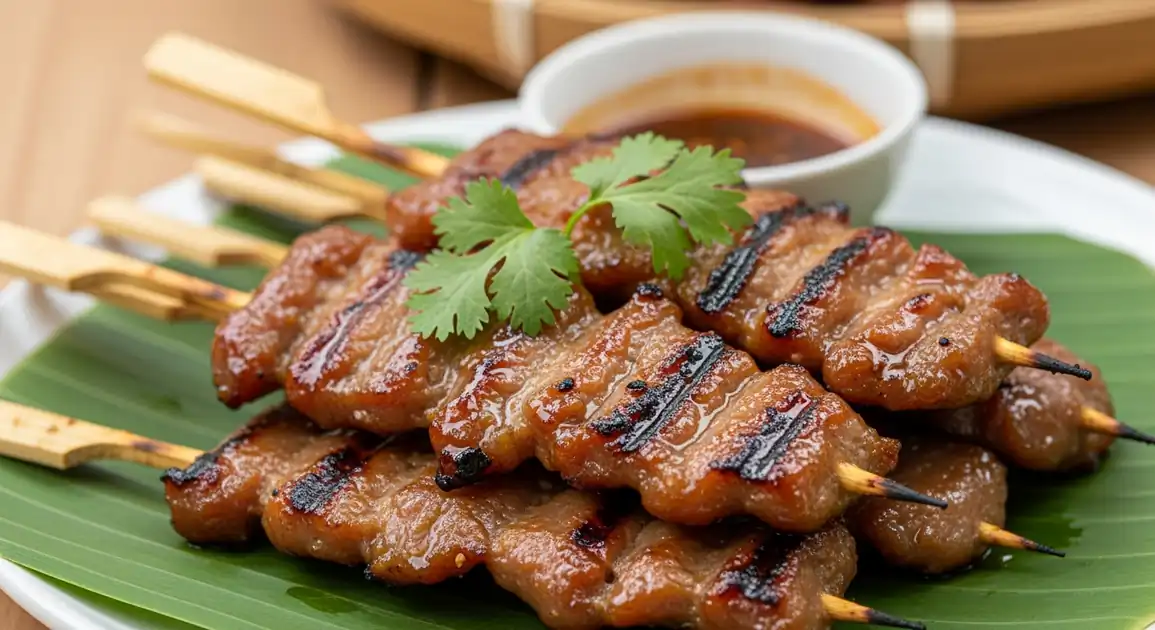Grilled Pork Skewers (Moo Ping)
หมูปิ้ง (Moo Ping)

Description
Moo Ping is ubiquitous throughout Thailand, appearing on virtually every street corner in the morning hours and at night markets in the evening. While the basic preparation remains consistent nationwide, subtle regional variations exist in marinade composition and accompanying sauces. Vendors range from simple mobile carts to established stalls with dedicated seating areas, particularly in tourist destinations.
Dietary Information
Serving information
Serving style
Typically served in a small plastic bag or wrapped in paper, with sticky rice separately packaged. Dipping sauce comes in a small plastic bag with a rubber band or in a small container. Eaten by hand while standing or walking, though some vendors offer basic seating.
Quick facts
Most traditional vendors operate 6 AM - 10 AM. Tourist area and night market vendors typically operate 5 PM - 11 PM or later.
Safety Tips
What to Look For
-
Meat being grilled fresh to order
Vendors should be actively grilling skewers throughout service, not pre-cooking large batches that sit out. Fresh grilling ensures both food safety and optimal texture.
-
Complete cooking with no pink/raw sections
Properly cooked pork should be opaque throughout with no pink areas, especially near the skewer. This is essential for eliminating potential parasites or bacteria.
-
Separate utensils for raw and cooked meat
Good vendors use different tongs or tools for handling raw skewers versus removing cooked ones from the grill to prevent cross-contamination.
-
Clean grill surface and work area
The cooking area should be reasonably clean, without excessive buildup of old food or grease. Raw meat should be kept covered when not being handled.
-
High customer turnover
Popular vendors with a steady stream of customers are more likely to have fresh ingredients and regular grill cleaning.
What to avoid
-
Pre-cooked skewers sitting at ambient temperature
Avoid vendors with large batches of pre-cooked skewers sitting out, especially if they're not being kept hot. This creates a high risk for bacterial growth.
-
Partially cooked or underdone meat
Pork must be thoroughly cooked to prevent foodborne illness. Avoid skewers with pink/raw areas or where the meat near the skewer looks undercooked.
-
Cross-contamination between raw and cooked food
If you observe a vendor touching raw meat and then handling cooked food without washing hands or changing gloves, choose a different vendor.
-
Old or reused marinade for basting
Be wary if you notice discolored, cloudy, or obviously reused marinade being applied to cooking meat. Fresh marinade should look relatively clear.
Price information
Price range
Budget tips
- Street vendors typically charge 10-15 THB per skewer, while touristy areas might charge 20-30 THB.
- Buying multiple skewers (5+) may sometimes get you a small discount.
- Adding sticky rice usually costs an additional 10 THB per portion.
- Morning markets generally offer better prices than night markets or tourist areas.
- Local neighborhood vendors away from main roads often charge less than those in commercial areas.
Value indicators
- Generous meat portions with minimal gristle or excessive fat.
- Caramelized exterior with visible marinade glaze.
- Complimentary dipping sauce included.
- Freshly grilled rather than pre-cooked and reheated.
- Proper tenderness without being tough or dry.
Where to Find This Dish
Morning Markets
Fresh markets (talad sod) throughout Thailand have multiple Moo Ping vendors, especially in the prepared food sections.
Local fresh markets, Outdoor market complexes, Neighborhood commercial areas
6 AM - 10 AM
Night Markets
Evening markets (talad nat) regularly feature Moo Ping vendors alongside other street foods.
Walking streets, Tourist night markets, Food courts
5 PM - 11 PM
Transportation Hubs
Areas near bus stations, train stations, and commuter areas often have Moo Ping vendors serving commuters.
Bus terminals, BTS/MRT stations, Main road intersections
6 AM - 9 AM, 4 PM - 7 PM
Vendor Tips
- Vendors with charcoal grills (rather than gas) often produce better flavor with authentic smokiness.
- Morning vendors typically have fresher meat and higher turnover.
- Look for vendors who adjust their grill height to control cooking temperature.
- Vendors who baste frequently during cooking produce juicier, more flavorful skewers.
How to Order
Regional Variations
-
Kor Moo Yang
(คอหมูย่าง)
Grilled pork neck skewers, using a more tender, fattier cut of meat with a similar marinade to traditional Moo Ping. The pork neck offers more juiciness and a softer texture.
-
Moo Ping Kra-tiem
(หมูปิ้งกระเทียม)
Garlic-heavy version with extra garlic in both the marinade and sometimes as pieces inserted between the pork chunks on the skewer.
-
Moo Ping Nam-Oi
(หมูปิ้งน้ำอ้อย)
A sweeter variation using cane sugar or honey in the marinade for extra caramelization and a more pronounced sweet flavor profile.
-
Moo Ping Saamchaan
(หมูปิ้งสามชั้น)
Made specifically with fatty pork belly (bacon) for a richer, more indulgent version with crispy fat and tender meat.
-
Moo Ping Isaan
(หมูปิ้งอีสาน)
Northeastern Thai style with distinct spices, often including more lemongrass, galangal, and sometimes a touch of toasted rice powder in the marinade.
Cultural context
History
Grilled meat on skewers is a cooking method found throughout Southeast Asia with variations in each country. Moo Ping evolved as a convenient, portable street food in Thailand, with regional adaptations based on local taste preferences. Originally a morning meal for workers, it has become a round-the-clock favorite for both locals and tourists. The dish represents Thailand's masterful balance of sweet, salty, and spicy flavors, along with the cultural significance of communal street dining that characterizes Thai food culture.
Local significance
Moo Ping represents Thailand's vibrant street food culture and the importance of convenient, flavorful meals in Thai daily life. It showcases the Thai culinary approach of balancing sweet, savory, and spicy elements within a single dish.
Eating customs
- Eaten by hand, alternating bites of meat with sticky rice.
- Sticky rice is often used to soak up the dipping sauce.
- The bamboo skewer is discarded after eating, never reused.
- Sometimes wrapped in a small piece of plastic bag for cleaner handling.